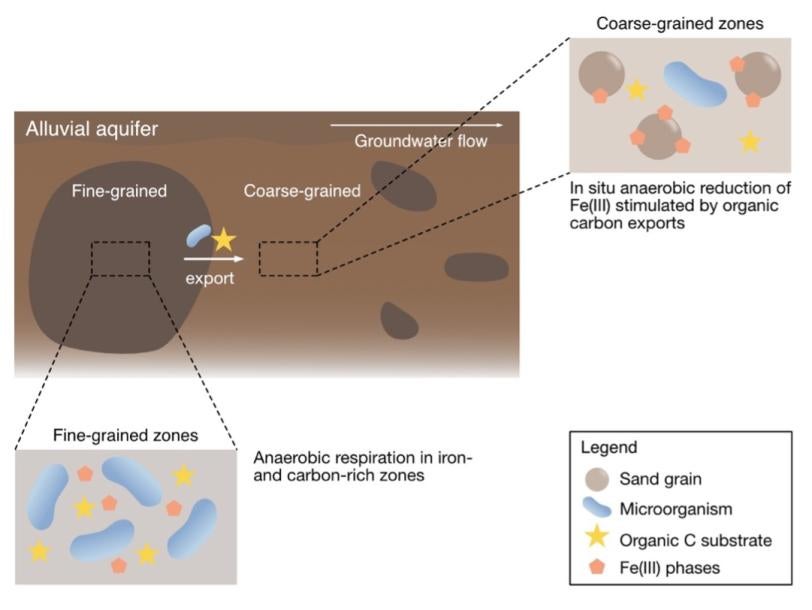Export of Organic Carbon from Reduced fine-grained Zones Governs Biogeochemical Reactivity in Aquifer
By

The Science
The chemical composition of groundwater is determined by complex chemical and biological processes occurring in the aquifer. An important factor in this regard are organic-rich, fine-grained sediment lenses that are embedded in otherwise sandy aquifers. Groundwater flowing through these lenses can transport various components of the lenses into the sandy zone of the aquifer and include processes that otherwise would not occur in the sand. Here, we show that both dissolved species, such as organic carbon compounds, as well as live microbial cells are exported from sediment lenses and induce anaerobic microbial respiration processes in the sand.
The Impact
Our work is the first to provide evidence for the export of live microbial cells from reduced sediments into sandy zones in a simulated aquifer. The export of live microbial cells together with dissolved organic carbon compounds induced microbial oxidation of organic carbon and reduction of iron in the sand. The occurrence of such anaerobic processes in the sand affects the mobility of micronutrients and contaminants that are sensitive to redox conditions with important implications for groundwater quality.
Summary
We assessed the influence of exports from sediment on aquifer biogeochemistry in a simulated aquifer in the laboratory. To this end, we built a column system with ferrihydrite-coated sand and embedded natural, reduced sediment lenses from the floodplains of Slate River (Crested Butte, Colorado) and Little Wind River (Riverton, Wyoming). We let groundwater flow through the columns and followed changes in porewater chemistry over time. After 50 days of groundwater flow, 8.8 +/- 0.7% and 14.8 +/-3.1% of the total organic carbon exported from the Slate and Little Wind River sediment lenses, respectively, had accumulated in the sand downstream. In addition, we observed an elevated abundance of 16S rRNA and iron-reducing gene copies, as well as elevated dissolved Fe(II) concentrations in the sand at the end of the groundwater flow. These results point toward in-situ microbial oxidation of organic carbon coupled to ferrihydrite reduction in the sand. Taken together, our findings suggest that organic carbon transport across interfaces contributes to downstream biogeochemical reactions in natural alluvial aquifers.
Contact
Kristin Boye
SLAC National Accelerator Laboratory
kboye@slac.stanford.edu
Funding
The project was conceived and supported by the SLAC Floodplain Hydro-Biogoechemistry Science Focus Area project funded by the Earth and Environmental Systems Sciences Division of the U.S. Department of Energy’s (DOE) Office of Science Biological and Environmental Research (BER) Program under contract no. DEAC0276SF00515SBR (SLAC National Accelerator Laboratory).
Publications
Aeppli, M., et al. "Export of organic carbon from reduced fine-grained zones governs biogeochemical reactivity in a simulated aquifer." Environmental Science and Technology 56 (4), 2738–2746 (2022). https://doi.org/10.1021/acs.est.1c04664.
Engel, M., et al. "Simulated aquifer heterogeneity leads to enhanced attenuation and multiple retention processes of zinc." Environmental Science and Technology 55 (5), 2939–2948 (2021). https://doi.org/10.1021/acs.est.0c06750.
Kumar, N., et al. "Redox heterogeneities promote thioarsenate formation and release into groundwater from low arsenic sediments." Environmental Science and Technology 55 (6), 3237–3244 (2020). https://doi.org/10.1021/acs.est.9b06502.
